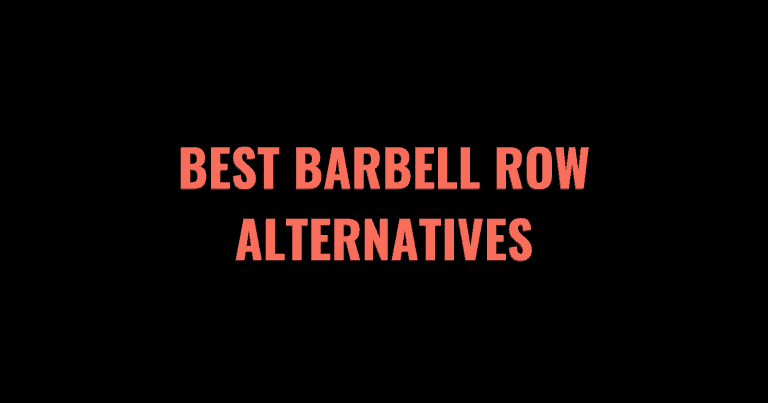Whether you’re a strength training newbie or an advanced weightlifter, pull-ups are one of the most impressive and practical exercises for your upper body. They are also one of the most difficult to execute correctly.
Whether you can do pull-ups or not, having alternate exercises to strengthen your back and biceps is a great way to keep your program effective.
Supplementing pull-ups with a range of alternative exercises helps strengthen the muscles required for a pull-up and builds a bigger, stronger back. Many of these alternatives also make great progressions, so you can use them to build the strength and confidence to get your first pull-up.
Here is our list of the 12 best pull-up alternatives and progressions.
Table of Contents
- 1 The 12 Best Pull-Up Alternatives
- 1.1 1. Chin-Ups
- 1.2 2. Wide-Grip Lat Pull-Downs
- 1.3 3. Inverted Bodyweight Rows
- 1.4 4. Straight Arm Lat Pull-Downs
- 1.5 5. Bent-Over Barbell Rows
- 1.6 6. Pull-Up Holds
- 1.7 7. Pull-Up Negatives
- 1.8 8. Machine-Assisted Pull-Ups
- 1.9 9. TRX Rows
- 1.10 10. Dumbbell Bent-Over Rows
- 1.11 11. Close Grip Pull-Downs
- 1.12 12. Renegade Rows
- 2 Reasons to Choose a Pull-Up Alternative
- 3 Muscles Worked by Pull-Ups
- 4 Pull-Up Alternatives: FAQs
- 5 Other Alternative Exercises
- 5.1 The 10 Best Pallof Press Alternatives
- 5.2 The 9 Best Pendlay Row Alternatives
- 5.3 The 8 Best Ab Rollout Alternatives
- 5.4 The 10 Best Lat Pulldown Alternatives
- 5.5 The 10 Best Bulgarian Split Squat Alternatives
- 5.6 The 10 Best Lying Leg Curl Alternatives
- 5.7 The 10 Best Front Squat Alternatives
- 5.8 The 10 Best Bench Press Alternatives
- 5.9 The 9 Best Seated Cable Row Alternatives (2023)
- 5.10 The 10 Best Bent Over Row Alternatives
- 5.11 The 9 Best Barbell Row Alternatives
- 5.12 The 10 Best Hack Squat Alternatives
- 5.13 The 10 Best Plank Alternatives
- 5.14 The 10 Best Leg Extension Alternatives
- 5.15 The 8 Best Incline Bench Press Alternative
The 12 Best Pull-Up Alternatives
- Chin-Ups
- Wide-Grip Lat Pull-Downs
- Inverted Bodyweight Rows
- Straight Arm Lat Pull-Downs
- Bent-Over Barbell Rows
- Pull-Up Holds
- Pull-Up Negatives
- Machine-Assisted Pull-Ups
- TRX Rows
- Dumbbell Bent-Over Rows
- Close Grip Pull-Downs
- Renegade Rows
1. Chin-Ups
When to Perform Chin-Ups
The chin-up is almost identical to the pull-up, except for your grip. Chin-ups use a supinated grip, with your palms facing towards you. Compared to traditional pull-ups, many lifters find this exercise an easier alternative. Chin-ups emphasize the biceps and lower lats, and help strengthen the muscles needed to improve your pull-ups.
How to Perform Chin Ups
- Reach up and grab a bar with a supinated grip (palms face you). Place your hands about 4 inches apart.
- Hang from the bar while retracting and pulling your shoulder blades down your back. Tuck your chin and gaze straight ahead.
- Squeeze your lats and biceps to lift your body until your chin hovers above the bar. Pause briefly.
- Slowly lower yourself back to the starting position. Fully lower yourself so your arms are extended.
- Reset by bracing the core and setting your shoulders.
- Repeat for the desired number of sets and reps.
Check out this useful video for a visual guide to performing chin-ups with proper form.
Tips for Chin-Ups
Keep your chin tucked and your spine neutral throughout this exercise to avoid injuring or straining your neck. Avoid kipping your lower body to generate momentum. Ensure your shoulder blades are pulling down your back throughout the exercise.
If you can’t do chin-ups, try practicing them on the pull-up machine or doing isometric chin-up holds to build strength and confidence with the exercise.
2. Wide-Grip Lat Pull-Downs
When to Perform Wide-Grip Lat Pull-Downs
The lat pull-down machine closely mimics the movement pattern of a pull-up. The only difference is instead of pulling your bodyweight upward against gravity; you pull a preloaded weight downward. Lat pull-downs on the machine are a great beginner-friendly alternative to pull-ups. They are also great for experienced lifters as you can load them with a weight heavier than your body weight to increase your strength. Using a wide grip for lat pull-downs will strengthen your lats, which are a limiting factor for many lifters when doing pull-ups.
How to Perform Wide-Grip Lat Pull-Downs
- Attach the long horizontal bar handle to the cable machine pulley.
- Set yourself up in a lat pull-down machine. Adjust the knee pads to comfortably secure your legs in place.
- Reach up and grab the bar with an overhand grip and your hands wider than shoulder-width.
- Plant your feet firmly on the ground. Sit up tall and pull your shoulder blades back and down away from your ears.
- Keep your chin tucked and gaze straight ahead.
- Squeeze your lats to pull the bar down towards you.
- Pause when your elbows are parallel to your ribcage, and the machine handle reaches your upper chest.
- Slowly return the bar to its starting position.
- Repeat for the desired number of reps and sets.
For a visual aid, check out this video from Bodybuilding.com.
Tips for Wide-Grip Lat Pull Downs
Maximize your strength gains by slowing down the eccentric phase of this exercise. In a lat pull-down, the eccentric phase occurs as the bar ascends. Stretch this portion of the lift out for 2-3 seconds to engage more muscle fibers and improve mind-to-muscle connection.
3. Inverted Bodyweight Rows
When to Perform Inverted Bodyweight Rows
The inverted bodyweight row is one of the best pull-up alternatives because they use identical muscle groups and a similar movement pattern. They help you build the confidence and strength to attempt your first pull-up or add additional volume when you have maxed out your pull-up reps. This exercise is a great progression for beginners and a fantastic accessory lift for deload weeks or when managing an injury.
How to Perform Inverted Bodyweight Rows
- Set up a barbell in a squat rack or smith machine. If you have access to J hooks, use these as they are more stable. Otherwise, consider loading the barbell with a moderate weight to provide a heavier anchor.
- Select the height you want for the exercise. The higher the bar is from the ground, the easier the movement will be.
- Position your body underneath the bar, so your nipples are in line with the barbell.
- Grip the bar with an overhand grip. Position your hands about an inch wider than shoulder-width distance.
- Brace your entire body to keep a rigid torso. Maintain some tension in the legs for added stability.
- Keep your chin tucked and gaze straight up.
- Squeeze your lats and rear delts to pull your body towards the bar.
- Hold at the top. Slowly lower yourself to return to the starting position.
- Repeat for the desired number of sets and reps.
Check out this video from Scott Herman Fitness for a visual guide to performing the inverted bodyweight row.
Tips for Inverted Bodyweight Rows
Inverted bodyweight rows are an easier pull-up version that builds strength and muscular endurance. Inverted rows can be made easier or harder, depending on your set-up. Having your body more horizontal (parallel to the ground) will make the exercise more difficult. Being more upright (raising the bar higher off the ground) will make it easier.
4. Straight Arm Lat Pull-Downs
When to Perform Straight Arm Lat Pull-Downs
Straight arm lat pull-downs are sometimes referred to as lat push-downs. They are a version of the lat pull-down that doesn’t involve elbow flexion. Keeping the elbows stationary reduces activity within the biceps and emphasizes the rear delt and teres major. Lifters managing an elbow injury or wanting to target postural muscles may prefer this alternative to the pull-up.
How to Perform Straight Arm Lat Pull-Downs
- Attach a straight bar handle to a cable machine high pulley.
- Grab the bar with an overhand grip and step back from the cable machine until you feel tension in the bar and your arms are extended.
- Maintain a micro-bend in your elbow and knees throughout the exercise.
- Keep your chest up and maintain a neutral neck position.
- Squeeze your lats to push the bar down and pull it towards you until it grazes your quads. Pause at the top of the rep.
- Slowly return the bar to its starting position.
- Repeat for the desired number of sets and reps.
For a visual aid, here’s a useful video from Renaissance Periodization.
Tips for Straight Arm Lat Pull-Downs
Make sure your wrists stay in line with your forearms and your elbows remain slightly bent. Initiate the exercise by squeezing your lats rather than pushing the bar down with your triceps.
5. Bent-Over Barbell Rows
When to Perform Bent-Over Barbell Rows
Bent-over barbell rows are one of the best exercises for building your back, lats, and biceps. They allow you to load the muscle groups used in a pull-up with heavy weights while engaging the core and spinal stabilizing muscles. Pull-ups are fantastic for building functional calisthenic strength, but if maximal hypertrophy is your goal, barbell rows may be more effective.
How to Perform Bent-Over Barbell Rows
- Stand with your feet hip-width apart and your loaded barbell on the ground in front of you. Engage your core and reach down to hold the barbell with an overhand grip. Your hands should be just wider than shoulder distance.
- Deadlift the bar and stand tall with the barbell in hand and a soft bend in the knees. Maintain a micro-bend in the knees throughout the exercise.
- Pull your shoulders back and down. Hinge your hips back and lean forward until your back is tilted to 45 degrees. Hold the bar close to the body throughout the exercise and keep your core activated.
- Squeeze your shoulder blades together and pull the barbell up towards your trunk. Avoid swinging or rocking your back to create momentum. Keep the elbows tucked in close to the body rather than allowing them to flare out.
- Keep your core braced and slowly release the barbell to the starting position. Repeat for the desired number of repetitions before lowering the barbell to the ground.
For a visual aid, here’s Alex Bromley from Empire Barbell.
Tips for Bent-Over Barbell Rows
Slow down your reps and move through a full range of motion to strengthen all the muscles in your posterior chain. Using a pronated grip for bent-over barbell rows will better emphasize the upper back muscles, including the rhomboids and trapezius. If you want to target your lats and mid-back, experiment with a supinated (underhand) grip.
6. Pull-Up Holds
When to Perform Pull-Up Holds
Failing to properly engage the lower lats, traps, and rhomboids holds many lifters back from doing pull-ups correctly. Isometric pull-up holds engage the muscles in your back and build a mind-to-muscle connection with any lagging muscle groups. Pull-up holds teach you how to retract your scapulae to make pull-ups easier and reduce the risk of injury or spinal compression.
How to Perform Pull-Up Holds
- Pull, jump, or use a platform to lift your body weight over a bar.
- Pull your shoulders down and squeeze them together.
- Tuck your chin and pull your elbows back to engage your lats.
- Hold for as long as you can with proper form, and lower yourself as slowly as you can, keeping the shoulders retracted and depressed the entire time.
- Repeat for as many reps as you can without compromising on form.
Check out this useful video for a visual guide to isometric pull-up holds.
Tips for Pull-Up Holds
Pull-up holds are a great alternative to pull-ups and a useful progression for lifters yet to do their first pull-up. If you can already do sets of pull-ups, isometric holds are a great exercise to superset with active pull-up reps to build more muscular endurance and perfect your form.
7. Pull-Up Negatives
When to Perform Pull-Up Negatives
Negative pull-ups are a variation that involves only the lowering (eccentric) phase of the pull-up. They are a great progression for those still getting used to pull-ups and experienced lifters wanting extra volume and technique work. Negative pull-ups build muscular strength and endurance in the rhomboids and lats and improve your grip strength for pull-ups and other exercises like deadlifts.
How to Perform Pull-Up Negatives
- Get into an isometric pull-up hold using a pronated (overhand) grip with your hands just wider than shoulder-width. If you can’t lift yourself over the bar, jump, or use a bench to stand on.
- Once your chin hovers above the bar, engage your core and squeeze your glutes. Tuck your chin and keep your gaze forward.
- Actively pull your shoulder blades towards each other and down.
- Extend your arms to lower your body towards the ground as slowly as you can, aiming for at least 3-5 seconds for the descent.
- Stop when your arms are extended, but a micro-bend remains in your elbow.
- Repeat by pulling, stepping or jumping back above the bar.
- Do as many reps as you can without compromising your form.
For a visual guide, here’s a useful video from Bodybuilding.com.
Tips for Performing Pull-Up Negatives
Advanced lifters can benefit from pull-up negatives by experimenting with tempo and pause positions. Pause during your sticking point in a pull-up to build mental stamina and improve your isometric strength.
8. Machine-Assisted Pull-Ups
When to Perform Machine-Assisted Pull-Ups
Machine-assisted pull-ups are the safest and least intimidating way to attempt your first pull-up. You should first experiment to find what weight to use to offset your body weight. You can then gradually reduce the amount of assistance until you feel confident going for your first unassisted pull-up.
How to Perform Machine-Assisted Pull-Ups
- Select the desired amount of counterweight and adjust the pull-up machine pin accordingly.
- Kneel on the padded platform and grab the bar with an overhand grip. Position your hands slightly wider than shoulder-width.
- Extend your arms to lower yourself into a dead hang.
- Engage your core to keep a neutral spine. Pull your shoulder blades down to lift yourself until your elbows are by your torso and your chin is higher than the bar.
- Hold for 1-2 seconds. Slowly extend the elbows to lower your body back down.
- Repeat for the desired number of reps and sets.
This video from PureGym provides a useful and beginner-friendly demonstration of how to use the pull-up machine.
Tips for Machine-Assisted Pull-Ups
If you don’t have access to a pull-up machine, you can also use long loop resistance bands attached to a high bar for assistance with pull-ups. If you use resistance bands, take extra care to come to a dead hang in between reps. The elasticity of a band can cause you to skip the hardest part of the pull-up by bouncing out of the bottom of the rep.
9. TRX Rows
When to Perform TRX Rows
TRX rows are similar to inverted bodyweight rows. However, when using a suspension trainer or a TRX, you need to use more stabilizing muscles. TRX rows allow you to customize your range of motion and vary your grip during each rep, which might be preferable if your shoulder mobility is poor. TRX rows place minimal stress on the lower back compared with other exercises like the bent-over barbell row.
How to Perform TRX Rows
- Check that the suspension trainer or TRX is secured to a stable overhead anchor.
- Grab the handles and plant your feet about hip-width distance apart. Select the incline that is appropriate for you. The more upright your body, the easier the exercise.
- Brace your abdominals and keep your body in a straight line as if you were holding a plank.
- Roll your shoulders back and pull your scapula down. Squeeze your back and lats to pull yourself towards the TRX handles.
- Hold at the top of the exercise for 1-2 seconds.
- Slowly extend your arms and lower your body to its starting position.
- Repeat for the desired number of sets and reps.
For a visual aid, check out this video demonstrating the correct form for a TRX row.
Tips for TRX Rows
Use the flexibility of the TRX to your advantage by adjusting your stance as needed. The lower the suspension trainer handles, the more difficult the exercise will be. Conversely, raising the TRX handles higher will position your torso in a more upright position and make the exercise easier.
10. Dumbbell Bent-Over Rows
When to Perform Dumbbell Bent-Over Rows
Weighted rowing variations like the unilateral dumbbell bent-over row are great for building a stronger back. Unilateral dumbbell bent-over rows cross-train your pull-ups because they help identify and address muscular imbalances. Ensuring the left and right sides of your body have equal strength will translate to greater bilateral strength, improved posture, and the ability to do more pull-ups.
How to Perform Dumbbell Bent-Over Rows
- Stand beside a bench and hold a dumbbell in your left hand with a neutral grip (palm facing towards your body).
- Place your right knee on the bench directly under your right hip and your left foot firmly planted on the ground for support.
- Place your right palm on the bench under your right shoulder. Tuck your chin and look straight down to keep a neutral spine.
- Take a breath in and engage your abdominals. Keep your shoulders pulled back.
- Exhale as you squeeze the rear delt to pull the dumbbell up towards your body so that your elbow travels behind your torso.
- Stop when the dumbbell reaches the side of your ribcage. Make sure the elbow remains close to your body and doesn’t flare out.
- Pause at the point of maximum muscle contraction before slowly lowering the dumbbell back to the ground.
- Repeat for the desired number of reps and then switch sides.
- Perform an even number of sets per arm.
This video provides a helpful visual guide for performing bent-over dumbbell rows.
Tips for Dumbbell Bent-Over Rows
Start with your weaker arm first and match the work on your more dominant arm to address muscular imbalances. Ensure you move through the full range of motion and keep your torso stable to eliminate any momentum. Slow down your reps, especially in the eccentric (lowering) phase, to get more time under tension and build strict strength.
11. Close Grip Pull-Downs
When to Perform Close Grip Pull-Downs
Close grip pull-downs using a v-bar are a great alternative to pull-ups. The shape of the v-bar keeps the elbows down and tucked into your sides, increasing the amount of shoulder extension needed to pull the weight towards you. Close grip pull-downs allow you to lean back slightly, increasing the amount of weight you can lift to strengthen your lats for pull-ups.
How to Perform Close Grip Pull-Downs
- Attach a v-bar to a cable machine high pulley and sit on a flat bench.
- Grip either side of the v-bar with a neutral grip (palms face each other).
- Keep your shoulders pulled down and engage your abdominals.
- Pull your elbows down and squeeze your lat to pull the handle towards you, leaning back slightly as you do so.
- Pause when the handle is almost touching your upper chest.
- Slowly return the handle to its starting position and sit up tall to reset.
- Repeat for the desired number of sets and reps.
Check out this helpful video demonstrating how to do the close-grip pull-down with proper form.
Tips for Close Grip Pull-Downs
Allow yourself to lean back slightly as you pull the handles towards you. Avoid rounding your back, ensuring it stays neutral and upright even as you lean back. Keep the exercise slow and controlled, and don’t use any momentum to pull the weight down.
12. Renegade Rows
When to Perform Renegade Rows
Renegade rows strengthen the same muscle groups as pull-ups while also improving your core strength. Renegade rows also address bilateral muscular imbalances and improve your grip strength and coordination. Renegade rows are convenient, requiring only a pair of dumbbells to give your back, lats, rhomboids, and obliques a great workout.
How to Perform Renegade Rows
- Place two dumbbells on the floor about shoulder-width apart. Hex dumbbells will be easier to balance on than dumbbells with a round edge.
- Assume a high plank position, gripping the dumbbells with a neutral grip. Ensure your shoulders are stacked directly above your wrists.
- Starting on your weaker arm, row one of the dumbbells by pulling your elbow directly behind you. Stop when the dumbbell is in line with your ribs. Balance on your feet and your non-working arm.
- Lower the dumbbell and repeat on the other side.
- Alternate sides for each rep until you perform the desired number of reps per side.
Here’s a useful video from BuiltLean demonstrating the correct form for dumbbell renegade rows.
Tips for Renegade Rows
Avoid rocking side to side as you row each dumbbell. Engage your core to keep your torso stable so that only your arms move. If you are struggling to balance, space your feet out wider for a more stable base. Protect your spine by keeping your gaze straight down between your hands and your chin tucked slightly.
Reasons to Choose a Pull-Up Alternative
Pull-ups are a fantastic exercise, but they aren’t right for everyone or every session. There are many reasons you may choose an alternative exercise to pull-ups. Some lifters do not currently have the strength to do a pull-up, especially if they are carrying excess body weight. Effective alternative exercises are also useful for beginners, people with poor chest and shoulder mobility, people with poor grip strength, and those managing an injury.
Muscles Worked by Pull-Ups
Pull-ups are a compound upper body exercise that utilizes several muscle groups, including those in your back, arms, and shoulders.
- Primary muscles used: Latissimus Dorsi, Biceps Brachii, Brachioradialis and Brachialis (Forearm Flexors), Infraspinatus (Rotator Cuff), Lower Trapezius (Traps).
- Secondary muscles used: Rear Deltoid, Rhomboids, Levator Scapulae, Pectoralis Major and Minor (Pecs).
Pull-Up Alternatives: FAQs
Why can’t I do a pull-up?
Pull-ups are an impressive feat of strength. If you’ve been training for a while and are yet to master the pull-up, don’t be discouraged. Common barriers to getting your first pull-up include poor shoulder and chest mobility, weak grip strength, excess body weight, and a weak posterior chain. Luckily, including the alternative exercises in this guide will get you well on your way to busting out pull-ups to impress your friends and fellow lifters.
Why do pull-ups hurt my shoulders?
The most common reason lifters experience shoulder pain when doing pull-ups is a lack of adequate scapular depression and retraction. Pulling your shoulders down and back is important for protecting your shoulder joint during this intense exercise. If you aren’t able to do pull-ups without shoulder pain, consider progressions and alternative exercises like inverted rows to build the strength and stamina to do pull-ups without causing discomfort or injury.
What can I use if I don’t have a pull-up bar?
You can substitute unassisted pull-ups with TRX or suspension trainer rows. You can also purchase a pair of gymnastics rings for a relatively low cost. Alternatively, you can do machine-assisted pull-ups or substitute other pulling exercises like barbell or dumbbell rows.
Other Alternative Exercises
If you enjoyed this post, check out our other roundups of the best alternatives for other exercises.













